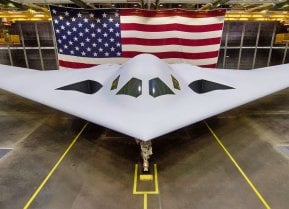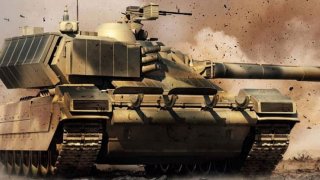T-95: The Remarkable Tank Russia Almost Built
The T-95 had the intimidation factor with the larger gun and higher turret. It probably would not have changed Russian armored tactics that much. It is not clear if the new armor would have stood the test against Javelin anti-tank missiles that attack the top of an enemy tank.
Summary: The Russian T-95 main battle tank, envisioned as a "super tank" to overawe NATO forces, showcased advanced features like a powerful 152mm gun, a remote-controlled turret, and enhanced armor but never entered mass production. Despite its potential, the T-95's innovations were eventually incorporated into the T-14 Armata. Originating in 1988, the T-95's development aimed to replace aging Soviet armor with a formidable presence on the battlefield. However, challenges, including the tank's performance in urban combat and subsequent shifts in manufacturing priorities, led to the project's cancellation. The T-95's capabilities, including its intimidating firepower and modern protection systems, hinted at a significant shift in Russian armored warfare that might have dramatically impacted force-on-force engagements, particularly against Ukrainian defenses. The T-95 remains a fascinating "what if" in military technology, symbolizing the transition towards the next generation of Russian tanks.
The T-95 Tank: Russia's Missed Opportunity for Armored Supremacy
On paper, the Russian T-95 main battle tank had it all.
It boasted a big and powerful gun with a remote-control turret. There was an auto-load feature and better armor. However, only a few prototypes were built, and they never made it to mass production.
The T-95 was too advanced and ahead of its time to be made in greater numbers. So many of the best design characteristics were integrated into the T-14 Armata.
So, even though it was a dry run for the T-14, it was probably better for the United States and European allies that they never saw the T-95 on the battlefield.
A Short History of the T-95
The T-95 had something of a complicated history and that didn’t help its future.
It started in 1988 and the program took years to hit its stride. The Soviets wanted to over-awe NATO opponents on the battlefield with a “super tank.” Think of the intimidation factor of the huge German Tiger tank in World War Two. Other Soviet armor such as the T-72 and T-80 was aging, so it was time for a change.
The Russian military got the Soviet’s inventory of tanks after the Cold War – including the T-80s that were made by the Omsktransmash manufacturer and the T-72 tanks that were built by Uralvagonzavod. Uralvagonzavod also produced the T-90.
Some Tank Needed to Be Better Against the Chechens
Omsktransmash started it off with its “Black Eagle” variant of the T-80.
But building something new from the T-80 was problematic. That tank performed horribly against Chechens in urban fighting when Russian tank crews clearly did not know how to fight a motivated counter-insurgency. The Black Eagle program was canceled in 2001, and the defense firm soon went out of business. Uralvagonzavod picked up the bankrupted company’s assets over the next couple of years.
Uralvagonzavod began work on what was to become the T-95 in 1995 with a program called Object 195. The Russian military kept details of this tank under wraps, hoping it would become the difference maker in Chechnya during the second Chechen war between 2000 and 2009.
The idea was to intimidate the Chechens and outclass any main battle tank that NATO would field going into the 2000s. The first feature was improving the main gun. The T-95 had a 152mm smoothbore model, more powerful than the gun on the American M1 Abrams and other allied tanks. That gun could fire all the modern, high-powered rounds you would expect from a new tank.
Powerful Gun Makes You Take Notice
Since the gun used a 152mm round, it matched the typical Russian artillery shell. So, the tank could also bring artillery fire to buildings, bunkers, and emplacements. Plus, it was equipped with over-the-horizon-guided missiles. Instead of a 7.62mm machine gun, it came with a coaxial 30mm cannon.
This would do significant damage to enemy troops and light armored vehicles in the open.
Remote-Controlled Turret, Powerful Engine, and Modern Armor System
The turret had a remote-control fire system and autoloader. This allowed the crew to stay deeper in the tank for better survivability. The turret was also higher - enabling the gun to be better elevated for shooting at taller buildings in urban combat.
The diesel engine was believed to have pushed out 1,500 horsepower. This was more powerful than the engines of the T-72 and T-80 and it would have enabled the T-95 to go faster than those Russian tanks.
The T-95 was also going to change the way Russians approached protective armor. It would have had the Relikt explosive reactive armor, composite armor, and an active protection system.
Improved Targeting Systems
The T-95 had thermal and optical sights but also has a radar gunsight situated above the barrel. The radar gunsight could be used effectively in a smoky battle space, an environment that usually defeats both optical and thermal sights.
The modern communications systems would have perhaps allowed the T-95 to receive targeting information from forward-deployed drones.
What About Anti-Tank Missiles?
The T-95 had the intimidation factor with the larger gun and higher turret. It probably would not have changed Russian armored tactics that much. It is not clear if the new armor would have stood the test against Javelin anti-tank missiles that attack the top of an enemy tank.
Ukrainian Military Would Have Been Outgunned
It’s probably a good thing for the United States and NATO allies the T-95 never came to fruition.
Moreover, Ukraine would have suffered too in a large force-on-force tank battle. T-95s could have been deployed on the Ukrainian border and would have outmatched any armor that the Ukrainians deployed. Ukraine’s best tank was the T-64 before the war. The T-64 does have a 125mm smoothbore gun and can launch guided missiles.
But it is much older – even the Russians do not field the T-64 in normal conditions - and it would have been a liability against the Russian T-95.
About the Author
Brent M. Eastwood, PhD, is the author of Humans, Machines, and Data: Future Trends in Warfare. He is an Emerging Threats expert and former U.S. Army Infantry officer. You can follow him on Twitter @BMEastwood.


